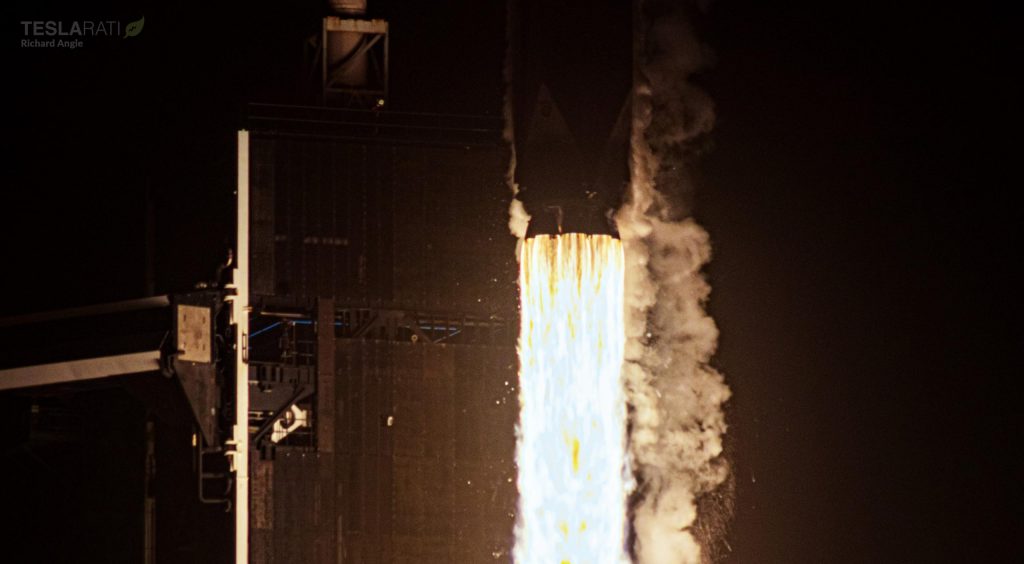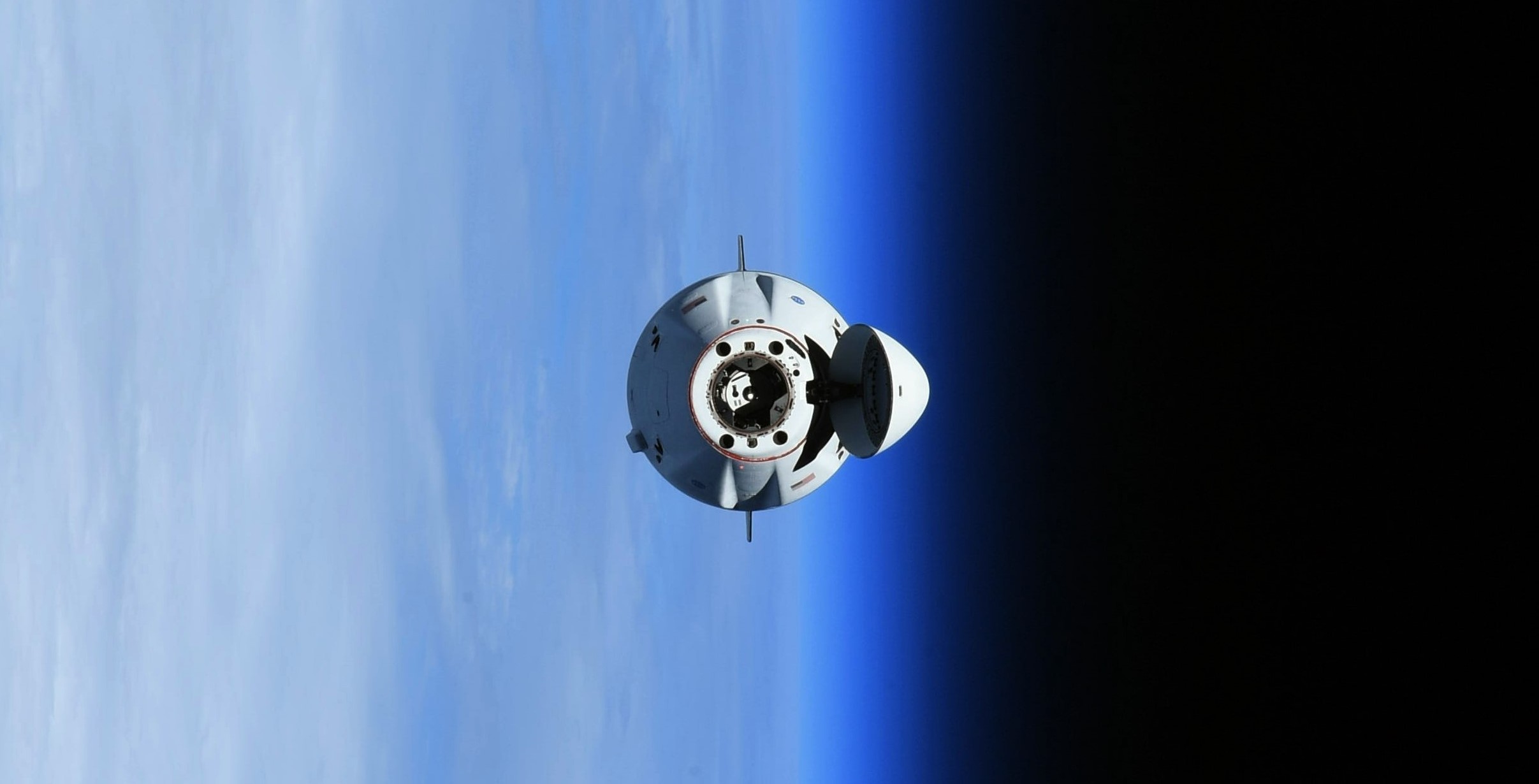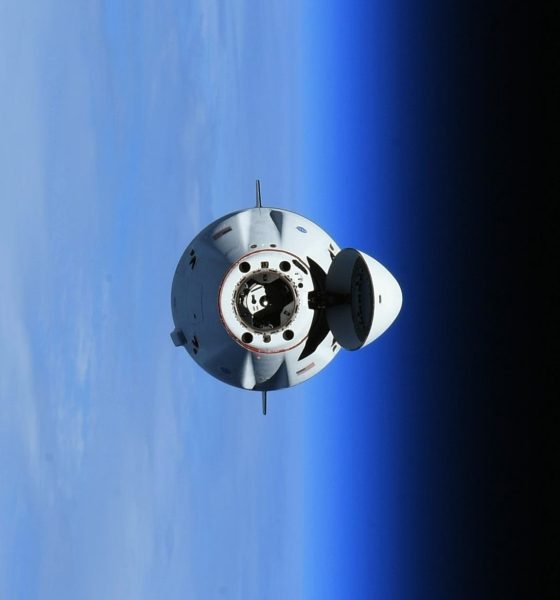For the fourth time in nine months, SpaceX has docked a Dragon spacecraft to the International Space Station with a second Dragon already present at the crewed orbital laboratory.
Launched Saturday on a Falcon 9 rocket after a one-day weather delay, SpaceX’s first upgraded Cargo Dragon 2 spacecraft gradually boosted and tweaked its orbit over the course of ~30 hours, looping around the Earth 20+ times before docking with the ISS more than half an hour ahead of schedule. Dragon’s Monday, August 30th arrival marked cargo capsule C208’s second space station docking in nine months, smashing SpaceX and the world’s turnaround record for a reusable orbital space capsule – of which Dragons are the only still flying.
SpaceX’s first twice-flown Crew Dragon was there to greet the first twice-flown Cargo Dragon 2 spacecraft when it docked, having spent the last four months in orbit in support of NASA’s second operational commercial crew mission (Crew-2). A similar instance of a pair Dragons meeting in space is likely to occur at least two more times before the end of 2021.


The first two-Dragons-one-ISS instance occurred just nine months ago when the very same Cargo Dragon 2 spacecraft (capsule C208) rendezvoused and docked with the ISS with SpaceX’s Crew-1 Crew Dragon already attached. At the time, in a number of press conferences and public statements centered around the launch of Crew-1 and CRS-21, SpaceX repeatedly hinted at just how prolific a year 2021 would be for Dragon and it’s hard to argue that the company was exaggerating.
Indeed, exactly as SpaceX foretold, Dragon spacecraft have maintained a continuous presence in orbit and repeatedly operated side by side at the ISS since Crew-1’s November 2021 launch. For the majority of NASA’s Commercial Crew Program development, that degree of continuous, single-provider operations was never meant to happen. SpaceX’s upgraded Cargo Dragon, for example, is one of two independent Commercial Resupply Services (CRS) spacecraft that regularly resupply the space station, ensuring redundancy in the event that one spacecraft or rocket runs into major issues. A third CRS vehicle – Sierra Nevada’s Dream Chaser spaceplane – will also begin cargo deliveries sometime next year.
NASA’s Commercial Crew Program was structured in the same way, with Boeing and SpaceX serving as two redundant crew transport providers. Of course, things didn’t go exactly according to plan and Boeing – despite receiving 60% (~$2B) more funding than SpaceX – has suffered numerous catastrophic issues in recent years, nearly dooming its Starliner spacecraft’s first uncrewed launch in December 2019 and ultimately delaying the company by two or more years.
After further issues delayed Starliner’s uncrewed do-over test flight (OFT-2) from August to late 2021 or early 2022, it’s entirely possible that SpaceX will operate as NASA’s sole crew transport solution for more than 18 months before Boeing flies a single astronaut. In other words, it’s likely that SpaceX will need to maintain the extraordinary cadence of Dragon launches demonstrated in 2021 well into 2022, and possibly even 2023. Since November 2020, SpaceX has launched three Cargo Dragon 2 resupply missions and eight astronauts on two Crew Dragons.
Another two NASA Dragon missions – Crew-3 and CRS-24 – are scheduled to launch in October and December 2021 and SpaceX’s first fully private Inspiration4 Crew Dragon launch could happen as early as September 15th. So long as Boeing’s Starliner is unable to fulfill its crew transport role, all future SpaceX Crew and Cargo missions for NASA – including Crew-3 and CRS-24 – will continue to see one Dragon meet another at the ISS. All told, barring possible delays to CRS-24, SpaceX is on track to launch eight Dragons – four Crew and four Cargo; 16 astronauts and 11 tons of space station supplies – in 13 months.
If Crew Dragon and Cargo Dragon 2 are considered to be two variants of the same Dragon 2 spacecraft, the only other instance in history where another orbital spacecraft came close to eight successful orbital launches in ~13 months was NASA’s Gemini Program, which completed eight crewed test flights in ~14 months in 1965 and 1966.
NASA’s Apollo spacecraft also completed six successful flights (5 crewed, 1 uncrewed) in 13 months in 1968 and 1969. Russian Soyuz vehicles – the most prolific crewed spacecraft in history – have also successfully flown 8 times in 13 months and 9 times in 14 months in the 1970s. Put simply, SpaceX’s Dragon program is now singlehandedly executing at or above the level of the two most prolific national space programs in history at funding peaks that haven’t been touched since and for a fraction of the cost.

News
Elon Musk’s Grokipedia surges to 5.6M articles, almost 79% of English Wikipedia
The explosive growth marks a major milestone for the AI-powered online encyclopedia, which was launched by Elon Musk’s xAI just months ago.

Elon Musk’s Grokipedia has grown to an impressive 5,615,201 articles as of today, closing in on 79% of the English Wikipedia’s current total of 7,119,376 articles.
The explosive growth marks a major milestone for the AI-powered online encyclopedia, which was launched by Elon Musk’s xAI just months ago. Needless to say, it would only be a matter of time before Grokipedia exceeds English Wikipedia in sheer volume.
Grokipedia’s rapid growth
xAI’s vision for Grokipedia emphasizes neutrality, while Grok’s reasoning capabilities allow for fast drafting and fact-checking. When Elon Musk announced the initiative in late September 2025, he noted that Grokipedia would be an improvement to Wikipedia because it would be designed to avoid bias.
At the time, Musk noted that Grokipedia “is a necessary step towards the xAI goal of understanding the Universe.”
Grokipedia was launched in late October, and while xAI was careful to list it only as Version 0.1 at the time, the online encyclopedia immediately earned praise. Wikipedia co-founder Larry Sanger highlighted the project’s innovative approach, noting how it leverages AI to fill knowledge gaps and enable rapid updates. Netizens also observed how Grokipedia tends to present articles in a more objective manner compared to Wikipedia, which is edited by humans.
Elon Musk’s ambitious plans
With 5,615,201 total articles, Grokipedia has now grown to almost 79% of English Wikipedia’s article base. This is incredibly quick, though Grokipedia remains text-only for now. xAI, for its part, has now updated the online encyclopedia’s iteration to v0.2.
Elon Musk has shared bold ideas for Grokipedia, including sending a record of the entire knowledge base to space as part of xAI’s mission to preserve and expand human understanding. At some point, Musk stated that Grokipedia will be renamed to Encyclopedia Galactica, and it will be sent to the cosmos.
“When Grokipedia is good enough (long way to go), we will change the name to Encyclopedia Galactica. It will be an open source distillation of all knowledge, including audio, images and video. Join xAI to help build the sci-fi version of the Library of Alexandria!” Musk wrote, adding in a later post that “Copies will be etched in stone and sent to the Moon, Mars and beyond. This time, it will not be lost.”
News
Tesla Model 3 becomes Netherlands’ best-selling used EV in 2025
More than one in ten second-hand electric cars sold in the country last year was a Tesla Model 3.

The Tesla Model 3 became the most popular used electric car in the Netherlands in 2025, cementing its dominance well beyond the country’s new-car market.
After years at the top of Dutch EV sales charts, the Model 3 now leads the country’s second-hand EV market by a wide margin, as record used-car purchases pushed electric vehicles further into the mainstream.
Model 3 takes a commanding lead
The Netherlands recorded more than 2.1 million used car sales last year, the highest level on record. Of those, roughly 4.8%, or about 102,000 vehicles, were electric. Within that growing segment, the Tesla Model 3 stood far ahead of its competitors.
In 2025 alone, 11,338 used Model 3s changed hands, giving the car an 11.1% share of the country’s entire used EV market. That means more than one in ten second-hand electric cars sold in the country last year was a Tesla Model 3, Auto Week Netherlands reported. The scale of its lead is striking: the gap between the Model 3 and the second-place finisher, the Volkswagen ID3, is more than 6,700 vehicles.
Rivals trail as residual values shape rankings
The Volkswagen ID.3 ranked a distant second, with 4,595 used units sold and a 4.5% market share. Close behind was the Audi e-tron, which placed third with 4,236 registrations. As noted by Auto Week Netherlands, relatively low residual values likely boosted the e-tron’s appeal in the used market, despite its higher original price.
Other strong performers included the Kia Niro, the Tesla Model Y, and the Hyundai Kona, highlighting continued demand for compact and midsize electric vehicles with proven range and reliability. No other model, however, came close to matching the Model 3’s scale or market presence.
News
Tesla Model Y Standard Long Range RWD launches in Europe
The update was announced by Tesla Europe & Middle East in a post on its official social media account on X.

Tesla has expanded the Model Y lineup in Europe with the introduction of the Standard Long Range RWD variant, which offers an impressive 657 km of WLTP range.
The update was announced by Tesla Europe & Middle East in a post on its official social media account on X.
Model Y Standard Long Range RWD Details
Tesla Europe & Middle East highlighted some of the Model Y Standard Long Range RWD’s most notable specs, from its 657 km of WLTP range to its 2,118 liters of cargo volume. More importantly, Tesla also noted that the newly released variant only consumes 12.7 kWh per 100 km, making it the most efficient Model Y to date.
The Model Y Standard provides a lower entry point for consumers who wish to enter the Tesla ecosystem at the lowest possible price. While the Model 3 Standard is still more affordable, some consumers might prefer the Model Y Standard due to its larger size and crossover form factor. The fact that the Model Y Standard is equipped with Tesla’s AI4 computer also makes it ready for FSD’s eventual rollout to the region.
Top Gear’s Model Y Standard review
Top Gear‘s recent review of the Tesla Model Y Standard highlighted some of the vehicle’s most notable features, such as its impressive real-world range, stellar infotainment system, and spacious interior. As per the publication, the Model Y Standard still retains a lot of what makes Tesla’s vehicles well-rounded, even if it’s been equipped with a simplified interior.
Top Gear compared the Model Y Standard to its rivals in the same segment. “The introduction of the Standard trim brings the Model Y in line with the entry price of most of its closest competition. In fact, it’s actually cheaper than a Peugeot e-3008 and costs £5k less than an entry-level Audi Q4 e-tron. It also makes the Ford Mustang Mach-E look a little short with its higher entry price and worse range,” the publication wrote.










